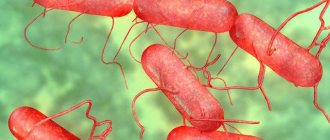Salmonellosis is a severe intestinal infectious disease, often leading to death if left untreated. Characteristic signs of infection include intestinal colic, fever, loose yellow or dark green stools, abdominal pain, and fever. The incubation period lasts from 3 days to a week.
The main “provocateurs” of salmonellosis are chicken eggs, dairy and meat products, but this does not mean that you can only become infected through them. There are other reasons why salmonellosis will not be long in coming.
Pathogenic Salmonella
When infected alimentarily (through food), Salmonella bacteria cause an acute intestinal infection in humans with severe symptoms of intoxication, which poses a real danger to human life. The severity of manifestations can be very acute.
Bacteria survive for a long time in the external environment and do not die in water or food. Infection occurs when the unprocessed product is eaten. The death of pathogens occurs when heated above 75 degrees , but does not occur when frozen.
Routes of infection
In addition to the direct consumption of foods poisoned by salmonella, the contact and household route of infection from a sick person, through close communication with him (living in the same apartment, sharing a ward, etc.), is widespread. How is salmonellosis transmitted under such conditions:
- through feces (if the patient does not wash his hands after using the toilet and touches objects in the room with them);
- close physical contact with an infected person;
- use of the patient's personal belongings.
People with weak immune systems (frequently ill, elderly and especially children) are most often susceptible to salmonellosis, since their body’s defenses cannot resist infections for various reasons. For others, the risk of developing the disease is relatively low.
How does salmonella get into food?
The main sources of bacteria are animals and poultry, in which the pathogen lives inside the intestines, in organs or muscles. Before consuming such meat or poultry products, they must be subjected to heat treatment. Many animals act as bacteria carriers, so they have no visible signs of disease.
From bird droppings, bacteria get onto the egg shell, initially concentrating only on the surface. If the shell is damaged or the dirty egg is stored for a long time, salmonella gets inside.
The bacterium maintains the ability to reproduce for up to 1 year even in frozen meat , accumulating toxic substances. Milk, liquid protein and meat are favorable breeding grounds. The appearance of the food does not change.
pH factor
There is no point in finding out the temperature at which salmonella multiplies on products - more effective destruction measures are known. Marinating in vinegar - the acid greatly lowers the pH factor of the medium, bacteria are destroyed. Botulism is eliminated, which is difficult to treat by boiling.
Salmonellosis close up
Salmonellosis is stable within the pH range from 3.7 to 9.5. Feels better in the range from 6.5 to 7.5 (alkaline environment). Trying to kill it with caustic soda is not a good idea. Acid is more productive. Housewives add it when canning.
In the stomach, the acidity of the medium (hydrochloric) reaches one. Most of the salmonella die. The stomach is an obstacle to pathogenic microflora. In the intestine, the contents of chyme become alkaline.
Don't guess how long it takes to cook the egg - just add vinegar to the recipe. The latter happens in the case of mayonnaise. Acidity is not low enough. The measure reduces the ability of the microbe to reproduce. In a jar of cucumbers, sealed for the winter, the microbe will probably die.
Where is Salmonella found in eggs?
Initially, the pathogen is contained in bird droppings, but if the shell is damaged, it can get inside. It doesn't really matter where the harmful bacteria is located, on the shell or inside the egg. The disease is considered quite dangerous, so food should always be cooked.
The shell must be clean and not covered with droppings. If a dirty product is broken into a frying pan or kitchen container, the likelihood of microbes getting into the white and yolk increases. This is why it is imperative to wash egg shells before cooking to protect against salmonellosis.
Salmonellosis is widespread among wild and domestic birds. It is dangerous to eat raw eggs not only of chickens and quails, but also of pigeons, geese, ducks and other winged animals.
Is there salmonella in quail eggs?
It is believed that quails and guinea fowl are not carriers of the infection, since the shells of their eggs are stronger and do not allow bacteria to penetrate inside. This opinion is a myth. In quails, salmonellosis in eggs cannot be completely excluded. Even if the body temperature of these birds is slightly higher than that of a chicken (about 42°C versus 41°C), this is still not enough to kill pathogens.
The only prerequisite for this misconception is that the pathogen is actually less often detected in quails than in chicken eggs. The latter can be explained by the fact that this type of bird is considered more valuable and expensive, and therefore is consumed less often.
How to check a product for infection?
Salmonella can be detected in a product only in laboratory conditions. But the risk of contracting the bacteria is much lower if the eggs purchased are fresh. Their shelf life at a storage temperature of 0-25 degrees is, according to GOST, 25 days from the date of sorting.
Eggs purchased at the local market are not marked, but their freshness can be checked in a simple way - by placing them in a container of cold water. Stale ones will turn over and rise with the blunt end up; very old ones may even float up.
If, after breaking an egg, you see that the yolk is very smeared, has lost its shape and has spread out into the white, then there is a possibility that it has been laid for a long time.
How to treat eggs against salmonellosis?
It is almost impossible to visually determine infection, since the presence of salmonella does not change the appearance or taste of food. Try not to buy anything in large crowded markets, or from strangers. The best supplier will be a farmer you personally know or a store that values its reputation.
To prevent dangerous pathogens from getting into your food, follow these simple guidelines :
- Do not eat soft-boiled eggs. Danger can lurk even if the yolk remains a little liquid. Thus, to ensure that salmonella is killed, eggs must be boiled for at least 10 minutes .
- Wash the product before breaking it. This significantly reduces the risk of infection.
- When frying scrambled eggs, break the yolk or fry the dish on both sides. There should be no liquid left in the dish before use.
- If the shell is cracked, it is recommended to hard-boil the product and then use it for food. To prepare omelettes or scrambled eggs, it is better to look for undamaged shells.
- Even after preparing a banal fried egg, it’s a good idea to wash your hands!
Safe cooking
Salmonella is a tenacious pathogen. It can withstand up to six months in water, and it doesn’t mind the cold: in deep freezing it remains viable for about 12 months.
But high temperatures are detrimental to it, and proper heat treatment of any product is the main enemy of salmonella. At what temperature does the pathogen die?
- at a minimum of 55 °C, the death of the bacterium occurs after an hour and a half;
- at 60 °C, after 12–15 minutes.
Thus, to be on the safe side, you need to ensure exposure to high temperatures for a sufficient amount of time. Doctors insist that eggs need to be boiled hard for at least 15 minutes (including goose and duck eggs). After this, salmonella does not survive, and the risk of infection is no longer guaranteed.
Where else does salmonella live?
Not only eggs, but also chicken meat are truly dangerous. Due to personal negative experiences, consumers begin to refuse such products.
According to studies by many laboratories, almost every third sample of chicken meat is infected with this pathogen. In China, this figure is even higher and amounts to 2/3 of meat, while in Western countries less than 10% of the product is contaminated. The prevalence is explained by the difficulty of combating the pathogen, as well as non-compliance with sanitary standards by the manufacturer or seller.
Pathogenic bacteria remain active in water, meat, dairy products, and soil. The source of infection can be any food, as well as dirty water or soil that gets into a plate of food (for example, at picnics). It is recommended to form the habit of always washing vegetables and fruits, and be sure to heat-treat meat.
Symptoms
Salmonellosis occurs in varying degrees of severity - in severe forms there is a high temperature, headache, vomiting, and severe intoxication of the body. In young children the disease is most severe. The incubation period ranges from 6 hours to 2 days. The most common is a localized form, in which the disease begins acutely. Along with symptoms of intoxication, patients experience nausea and profuse repeated vomiting, liquid, foul-smelling, foamy, brown or greenish diarrhea. The abdomen is swollen and painful around the navel; on the right, in the lower abdomen, rumbling is disturbing. Most often, body temperature is elevated. Blood pressure decreases, pulse quickens, headache and weakness occur. As a result of large losses of fluid and salts in the stool, patients often develop convulsions. Generalized forms of salmonellosis can begin as a continuation of the localized form, that is, with damage to the gastrointestinal tract, or they can occur from the very beginning without loose stools and abdominal pain. Usually, with a typhus-like form, symptoms of intoxication come to the fore, and it is very reminiscent of typhoid fever and paratyphoid fever. Less often, patients develop shaking chills, profuse sweating, the temperature curve becomes irregular, and the disease loses its cyclicity. The liver and spleen enlarge. An unfavorable outcome is possible. With any form of salmonellosis, the formation of bacterial carriage is possible when the pathogen is detected in the feces of patients.
Why is salmonellosis dangerous?
The pathogen attacks the small intestine, where bacteria begin to multiply and penetrate nearby tissues. Foci of inflammation with possible purulent processes form at the site of the lesion. The destruction of bacteria is accompanied by the release of toxins, which have an extremely negative effect on the functioning of human internal organs. The main symptoms include high fever, severe dehydration, vomiting with diarrhea, and infectious-toxic shock.
Death usually occurs due to loss of large amounts of fluid, decreased arterial pressure, and hypovolemic shock (a condition associated with a sharp drop in circulating blood volume).
Do not try to treat the infection yourself! There is no home treatment for salmonellosis. Symptoms may be so severe that the patient is unable to care for themselves. In addition, high antibiotic resistance is observed in this disease. If your condition worsens or you have persistent loose diarrhea, contact your doctor immediately to prevent severe dehydration. Therapy often involves hospitalization with the prescription of etiotropic and symptomatic therapy.
Salmonella is a causative agent of infectious diseases that is often resistant to antimicrobial agents. Infection can be easily prevented by following normal preventive measures. Do not eat raw eggs and meat, subject the ingredients of your dishes to proper heat treatment.
Symptoms of the disease
Salmonellosis is recognized by such signs as:
- increased body temperature;
- muscle pain;
- dizziness;
- sharp abdominal pain;
- nausea;
- severe vomiting;
- bloating;
- diarrhea;
- skin rash.
Salmonellosis is dangerous because:
- vomiting causes severe dehydration of the body;
- the development of infection causes inflammation of the muscles, joints, brain, heart muscle;
- with an increase in the concentration of harmful bacteria, the process of digestion and defecation is disrupted, and disruptions in the functioning of the central nervous system occur;
- When infected with Salmonella, fatal cases cannot be ruled out.
Is this treatable?
Salmonellosis is highly treatable; the doctor may not even prescribe antibiotics.
But under no circumstances should you try to heroically crawl to work or endure the disease on your feet, even if it is mild.
- Salmonellosis is contagious to others.
- The disease can cause serious complications.
- After symptoms disappear, a person may remain a carrier or a chronic patient.
If you suspect you have become infected
- stay home
- limit contact with family
- ask your loved ones to disinfect the bathrooms after each visit
- drink more water
Let the water have electrolytes and glucose - just add a little salt and sugar. This way you will replenish your water-salt balance and get additional energy.
Is it possible to do without an infectious diseases hospital?
You can stay at home, but hospitalization will be required if the illness becomes severe. It’s time to go to the infectious disease clinic in the following cases:
- If you can't hold water
- If your diarrhea becomes particularly painful, slimy, or bloody
As with many other diseases, delay can make the situation much worse.
At the hospital, you will be given a drip to replenish fluid loss - dehydration can be more dangerous than the disease itself. It can even lead to a heart attack because the blood becomes too thick.









